Duck Eggs Duck on a Nest Clip Art Black and White
If you know ducks well, you'll know they come in various breeds, shapes, sizes, and colors. They tin have differently shaped bills, unique middle colors, and other characteristics that make them stand out from each other.
One the the easiest means to try to tell duck breeds autonomously by sight is by the colour of their plume. Duck feathers come in many different shades and combinations, and not all of them are one solid color.
Ducks with a mix of black and white coloring are unique to expect at and more mutual than you lot might realize. Permit's take a closer look at duck breeds that are known for their blend of blackness and white plumage.
1. Magpie Duck
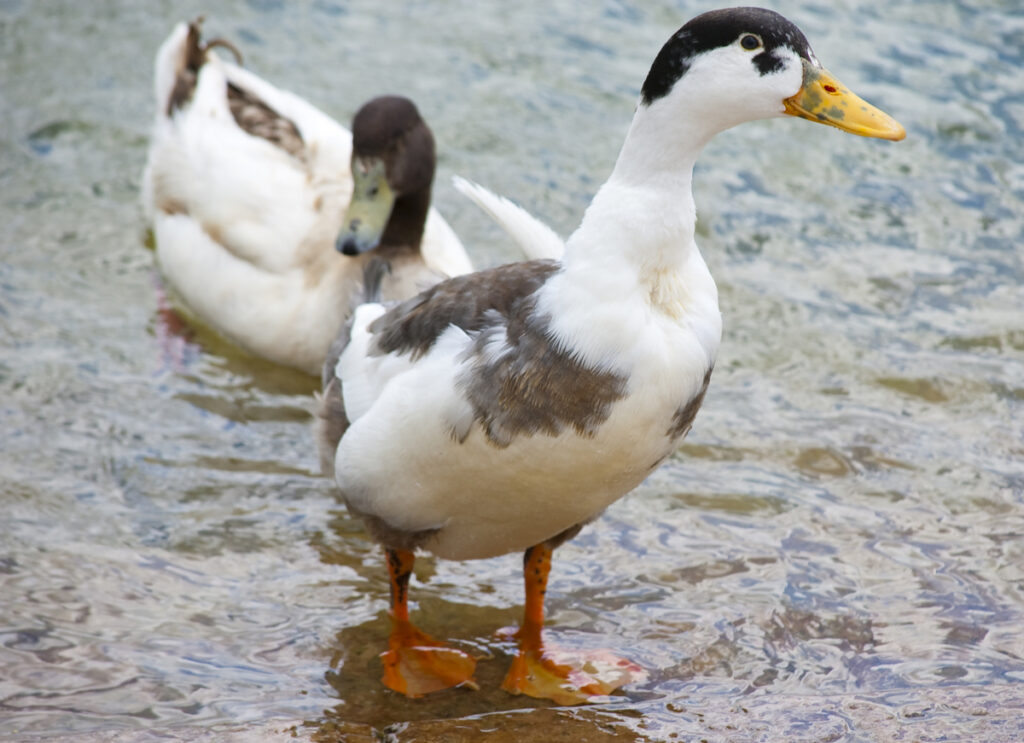
Magpie ducks were developed in Wales toward the finish of the First World War. M.C. Gower-Williams and Oliver Drake are credited with the development of this breed in the United Kingdom.
The Magpie brood is thought to accept originated from the Huttegem and Indian Runner Duck breeds. The Huttegem was an sometime Belgian breed that may have gone extinct in 2011.
Magpies are domesticated lightweight ducks weighing around iv-5 pounds. A large function of their plumage is white, just it is variated with black patches.
They too have black feathers on the top of their head, their back, and scattered on their wings. Their bills and feet are xanthous or orange, just as they go older, they may become green.
While they were prevalent in the United Kingdom in the early 1900s, they didn't debut in the United States until 1963. In 1977, Magpie ducks became recognized by the American Poultry Association. Their conservation status was listed as critical in 2007.
Magpies are quite the foragers; they chase for about of the things they eat. They consume grass, insects, slugs, seeds, and snails.
Magpies ducks are kept for their meat and eggs. They lay 220-290 eggs per year and alive for up to 9 years. Magpie ducks are active and easy to control.
2. Ancona Duck
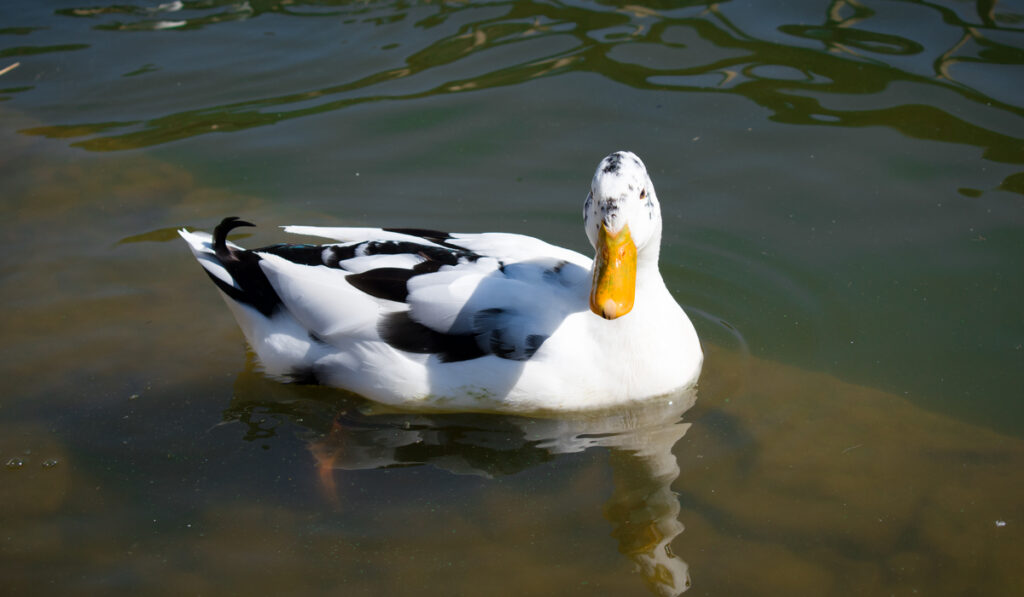
Ancona ducks may have originated from either Great Uk or the United States in the early 1900s. Like Magpie ducks, Ancona ducks are thought to have descended from Huttegem and Indian Runner ducks.
Ancona ducks take plumage with two-toned, blackness and white feathers. Well-nigh of their plume is white, simply y'all'll find black patches accenting their cheeks, face, cap, dorsum, sides, wings, and shoulders. Their bills and feet are yellow with some black patches.
Ancona ducks are medium-sized domestic ducks with an boilerplate weight of half dozen-6.5 pounds. Compared to the closely related Magpie ducks, Anconas are sturdier.
This duck brood is commonly kept for their eggs and meat, and they lay as many as 210-280 white eggs per year. The eggs can likewise be tan, cream, spotted, or blue.
You'll rarely discover Anconas flying. They are active only unlikely to wander far from dwelling. Ancona ducks are besides great foragers, and they usually supplement whatsoever feed y'all provide with bugs, grass, seeds, weeds, and worms.
3. Muscovy Duck
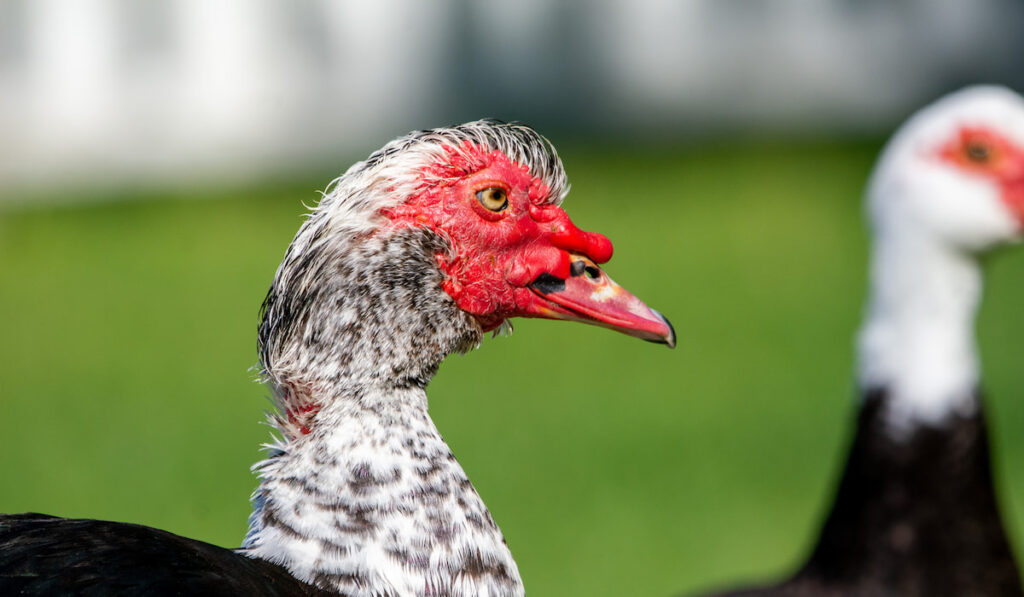
Muscovy ducks are one of the oldest domesticated fowls in the world. Wild Muscovy ducks alive in Argentina, northern United mexican states, and southern Texas in coastal regions and lowland areas.
Muscovy ducks are also widely domesticated throughout North America and can be found on farms and in parks.
Male Muscovy ducks are the largest ducks in Due north America. They have predominantly black plumage with white patches in their wings.
The blackness feathers on their backs take green iridescence, their faces take reddish warts, and they have dark grey bills and feet.
Female Muscovy ducks are big bodied and predominantly blackness. They have long necks, white patches in their wings, dark-grayness bills, and nighttime gray anxiety.
They feed on plants and animals. Some of these include seeds, sedges, tubers, grasses, insect larvae, spiders, reptiles, and fish.
They are typically raised for their meat, simply some farmers proceed them on manus to bulldoze away snakes and mice.
On average, Muscovy ducks lay 8-fifteen eggs per nesting with an incubation period of 30-31 days. Their eggs are normally glossy white but sometimes take a vitrify or greenish color.
4. Pomeranian Duck

Pomeranian ducks originated from Pomerania in Frg as a crossbreed. They share an ancestry with some northern European ducks including Shetland ducks and Swedish Blue ducks, and they are considered quite rare.
Pomeranian ducks are landrace ducks. They are found in gardens, poultries, and farms beyond northeastern Europe especially between Frg and Sweden.
Pomeranian ducks come in blue and black varieties. Pomeranian ducks with blackness feather take a green sheen and a white patch around their breast region. Their eyes are night brown, and their bills are black.
They are kept for ornamental purposes, for eggs, and for meat. On boilerplate, they lay 70-100 white or blue eggs every year. Their eggs accept an incubation period of 26-28 days.
One interesting fact about Pomeranian ducks is that they are known to quack loudly to welcome visitors. This makes them useful equally baby-sit animals.
Pomeranian ducks eat both plants and insects. They feed on various bugs, slugs, rice bran, and snails. Most Pomeranian ducks alive for 4-viii years, but some have lived for upward to 12 years.
five. Crested Duck
Crested ducks become their name from the tuft of feathers atop their heads. This brood comes in a variety of unlike plume colors. They can be all white, all black, or a mix of black and white.
Crested ducks are medium-sized waterfowl that have been around for over 4 centuries. They entered the United states in the mid-1800s. The white variety was admitted into the American Poultry Association's standard in 1874, and the blackness diverseness was added in 1977.
Crested ducks are kept for 2 main reasons: eggs and meat. They lay cream-colored eggs with a clutch size of five-viii and an incubation period of effectually 30 days. Crested ducks are friendly, calm, and they abound quite fast.
6. Tufted Duck
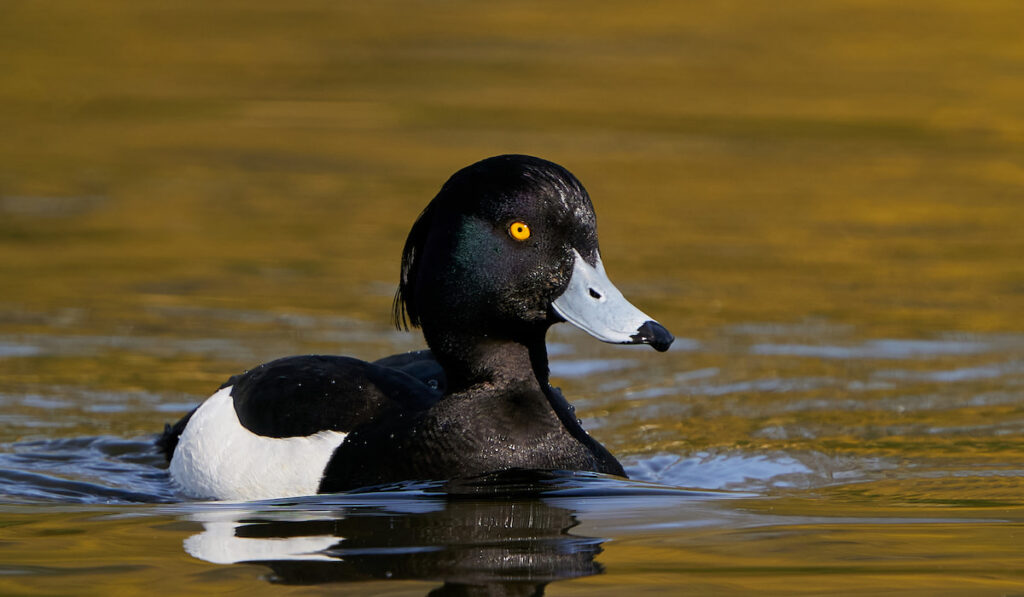
Tufted ducks originated in the Palearctic region, but you tin at present observe them in parts of Africa, Eurasia, and N America. Tufted ducks breed between May and Baronial.
During this menstruum, they spend more time in areas such equally Norway, the British Isles, Faroe Islands, and almost all of Europe.
In winter, they motion toward northern Africa, southern Europe, Southern asia, and Due north America.
Tufted ducks occupy temperate saltwater and freshwater. You'll commonly discover them in shallow waters with thick vegetation.
Tufted ducks are medium sized, and the drakes are noticeably larger than the females. The tuft on the back of their head earns them their name, and this is one feature unique to them when compared to other members of the Anatidae family.
Male person Tufted ducks accept predominantly blackness plumage, just their underbellies and sides have white patches.
Female Tufted ducks accept black plume with brown and white patches. Both genders have black bills and black and grayness feet.
Tufted ducks are monogamous. They build their nests close to water in thick vegetation. On average, they lay betwixt half-dozen-14 eggs per nesting with an incubation flow of 26-27 days.
Tufted ducks will eat plants such as seeds, grains, basics, and tubers, and animals such as mollusks, fishes, and insects.
7. Greater Scaup
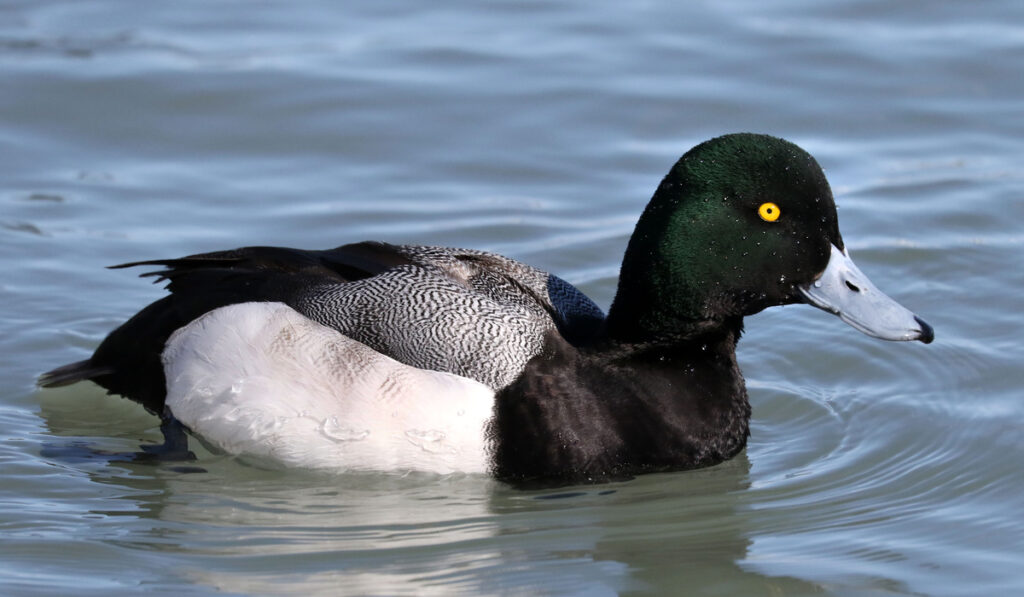
The Greater Scaup is the only diving duck living well-nigh one of the Globe's poles. For spring breeding, they motility toward tundra regions in Europe and North America. In winter, they migrate toward the Atlantic and Pacific coasts.
Greater Scaups have rounded heads, bluish beaks, and xanthous eyes. For the drakes, their plumage is blackness, their flanks are white, and their back is gray.
The females have brown feather with white patches around the base of operations of their bills.
They feed on aquatic plants, seeds, insects, crustaceans, and mollusks. They build their nest on the ground in areas close to h2o with dense sedges and grasses.
Greater Scaups have a clutch size of 5-13 and an incubation period of 23-28 days. Their population is currently in pass up in the wild.
8. Bufflehead Duck
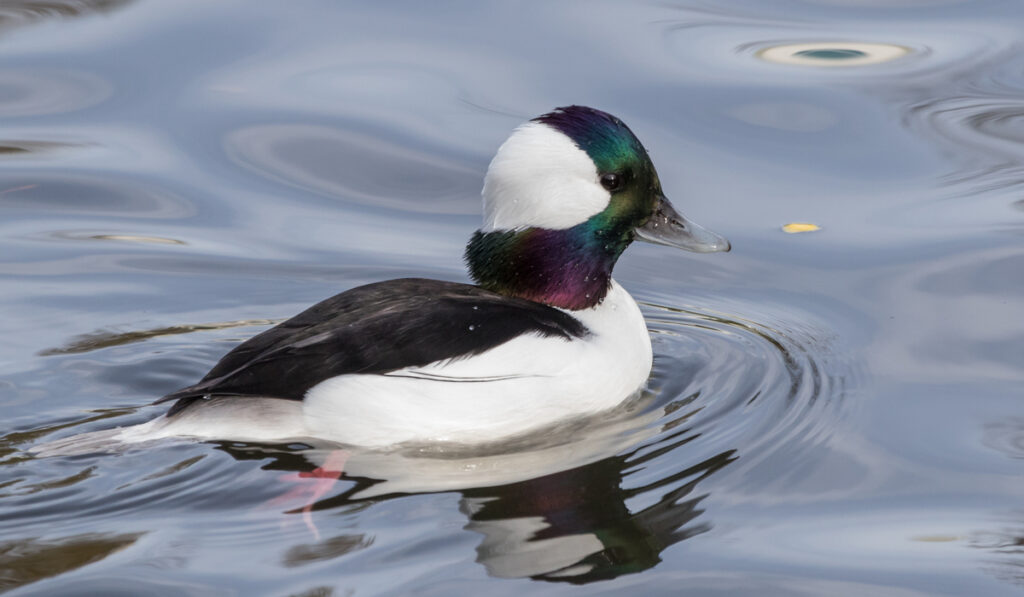
Bufflehead ducks are the smallest diving ducks in N America, and they are normally seen around lakes and ponds.
You'll find isolated populations of this breed in the western Usa, but they are more common in the aspen parklands and boreal forests of Alaska and Canada.
Male Buffleheads have blackness and white feathers on their large heads that are easily noticed from a distance. The black feathers around the base of operations of the bill gives off a purple-dark-green iridescence.
Bufflehead ducks females have black to dark brown feather with a white patch on their cheeks.
While flying, both male and female Bufflehead ducks reveal white stripes on their wings.
Buffleheads mainly eat aquatic invertebrates such every bit insect larvae, mollusks, and crustaceans. They are keen swimmers and divers.
They fly at lower altitudes when above water and then dive for betwixt 12-25 seconds to get their food. They usually swallow their catch while underwater, and so render to higher altitudes once out of the water and over land.
When fall and winter get in, Bufflehead ducks incorporate establish matter in their nutrition. During these seasons, they eat seeds from bulrush and pondweed plants.
This breed lays buff or cream-colored eggs. For each nesting, they lay betwixt 4-17 eggs with an incubation period of 28-33 days.
Resource
- https://www.allaboutbirds.org/guide/Bufflehead/
- https://livestockconservancy.org/index.php/heritage/internal/magpie
- https://www.beautyofbirds.com/magpieducks.html
- https://backyardpoultry.iamcountryside.com/poultry-101/all-about-ancona-ducks/
- https://livestockconservancy.org/index.php/heritage/internal/anconaduck
- https://www.allaboutbirds.org/guide/Muscovy_Duck/
- https://www.breedslist.com/pomeranian-duck.htm
- https://domesticanimalbreeds.com/pomeranian-duck-breed-everything-you-need-to-know/
- https://world wide web.roysfarm.com/crested-duck/
- https://animaldiversity.org/accounts/Aythya_fuligula/
- https://www.rspb.org.u.k./birds-and-wildlife/wildlife-guides/bird-a-z/tufted-duck/
- https://www.allaboutbirds.org/guide/Greater_Scaup/
Source: https://farmhouseguide.com/black-and-white-duck-breeds/